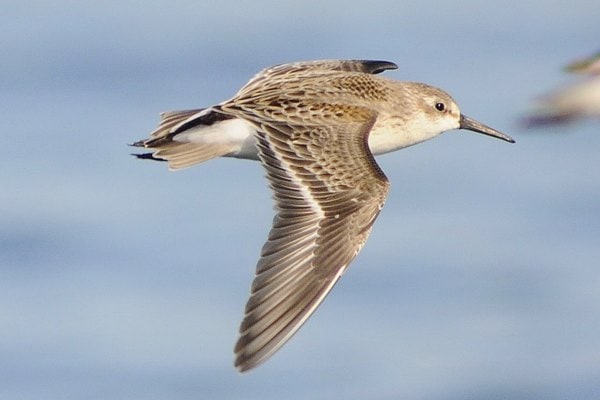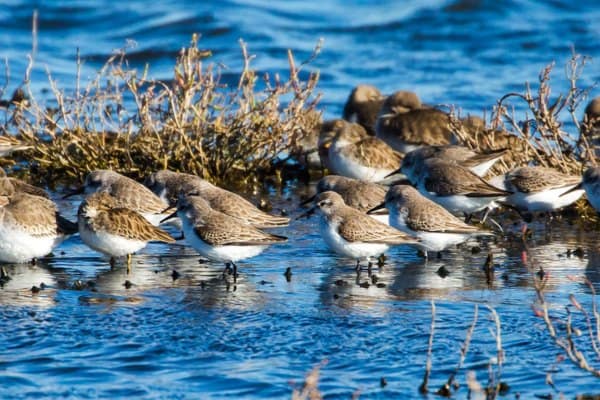Common Name: Western Sandpiper
Scientific Name: (Calidris mauri)| Size | Diet | Range in Hawaii | Status in Hawaii |
|---|---|---|---|
| 6 in. - 7 in. | crustaceans, mollusks, insects, and even small worms | Kaua'i, O'ahu, Moloka'i, Maui, and Big Island | Least Concern |
The Western Sandpiper, also known as Calidris mauri, is a small shorebird species that is native to North America. While the species is not native to Hawaii, it has been known to occasionally visit the islands as a non-breeding visitor and occasional winterer. With its unique appearance and distinctive foraging behavior, the Western Sandpiper is a fascinating bird species that has captured the attention of birdwatchers and avian enthusiasts around the world.
In this article, we will explore the world of the Western Sandpiper, its unique characteristics, and its occasional presence in Hawaii.
Western Sandpiper
Appearance

The Western Sandpiper is a captivating shorebird with a striking appearance. It stands out with its petite size, measuring around 6 to 7 inches (15 to 18 centimeters) in length. Its plumage features subtle shades of brown and gray, creating an elegant yet understated look. One of its distinguishing characteristics is its slender bill, which aids in its foraging along coastal shores.
Diet
The Western Sandpiper boasts a fascinating diet that perfectly suits its coastal lifestyle. These agile shorebirds are expert foragers, primarily feasting on a buffet of tiny invertebrates. Their menu includes delectable treats like tiny crustaceans, mollusks, insects, and even small worms.
Nesting
These small shorebirds typically choose their nesting grounds in the Arctic tundra of northeastern Siberia and Alaska. Here, amidst the rugged beauty of the far north, they create their shallow nests lined with soft plant materials.
What’s truly remarkable is their synchronized nesting strategy. Western Sandpipers often nest in colonies, where hundreds or even thousands of pairs of these birds come together to raise their young. This communal approach offers safety in numbers, as vigilant parents take turns incubating their precious eggs.
Once the chicks hatch, they embark on a rapid growth journey, developing quickly to face the harsh Arctic conditions. Witnessing the Western Sandpiper’s nesting behavior reminds us of the tenacity and adaptability of life in some of the world’s most extreme environments.
Behavior

These agile birds are known for their energetic foraging antics along coastal shores, where they dash back and forth with remarkable speed, probing into wet sand and mud to uncover their favorite delicacies.
During migration, Western Sandpipers embark on epic journeys, covering thousands of miles from their breeding grounds in the Arctic to wintering habitats along both American coasts. They often gather in large flocks, creating mesmerizing patterns in the sky as they migrate.
Intriguingly, these sandpipers are also social birds, forming colonies for nesting in the Arctic tundra. Their cooperative parenting efforts involve shared incubation and chick-rearing duties among colony members, highlighting their sense of community.
Habitat

These charismatic shorebirds are commonly found in estuaries, mudflats, and sandy beaches along the shorelines of North and South America. During their breeding season, Western Sandpipers venture to the remote Arctic tundra of northeastern Siberia and Alaska, where they select nesting sites amidst the vast, rugged landscapes.
In winter, they migrate to both the western and eastern coasts of the Americas, where they can be seen bustling along the tideline, foraging for tiny invertebrates.
Range
The Western Sandpiper is a non-breeding visitor and occasional winterer in Hawaii. Western Sandpiper has been documented in various Hawaiian Islands, including Kaua’i, O’ahu, Moloka’i, Maui, and Hawai’i Island. These sightings confirm its presence across the Hawaiian archipelago during migration and wintering periods.
Conservation Status
The Western Sandpiper (Calidris mauri) is classified as a species of “Least Concern” on the International Union for Conservation of Nature (IUCN) Red List. However, please note that conservation statuses can change over time based on new data and assessments.
Interesting Facts
1. Molt migration
These birds exhibit a phenomenon known as “molt migration.” Instead of molting at their breeding grounds, they undertake a migration to molting sites before returning to their breeding areas. This behavior is thought to be related to the availability of food resources.
2. Vocal communicators
Western Sandpipers are known for their soft, trilling calls, which they use for communication within their flocks during migration and while foraging.
3. Hybridization
Occasionally, Western Sandpipers interbreed with other sandpiper species, leading to hybrid individuals. This hybridization can make identification challenging for birdwatchers.
4. Wing displays
During courtship displays, Western Sandpipers often perform intricate aerial dances. They extend and flutter their wings while making high-pitched calls to attract mates.
5. Climate change indicators
Because of their sensitivity to environmental changes, Western Sandpipers are often considered as indicators of climate change. Their migration timing and breeding success can be influenced by temperature and food availability.
Frequently Asked Questions
1. Are there different subspecies of Western Sandpipers?
Western Sandpipers are generally considered monotypic, meaning they do not have recognized subspecies.
2. Can I attract Western Sandpipers to my backyard or birdwatching area?
Western Sandpipers are typically found in coastal habitats and are not common backyard birds. Observing them may require visiting their natural habitats during the appropriate seasons.
3. What is the typical lifespan of a Western Sandpiper?
Western Sandpipers can live relatively long lives for small shorebirds. While many factors can influence their lifespan, they are known to survive for up to 14 years in the wild. However, the average lifespan in their natural habitat may be shorter due to predation, environmental challenges, and other factors.
4. Can I spot Western Sandpipers in regions other than the Americas?
Yes, Western Sandpipers have been recorded in various parts of the world during migration, including the Galapagos Islands, Japan, and New Zealand
5. What are the threats to Western Sandpipers in their Arctic breeding grounds?
Climate change is a significant threat, as it can alter the timing of insect hatches, affecting food availability for chicks. Nest predation by Arctic foxes and jaegers is also a concern.




